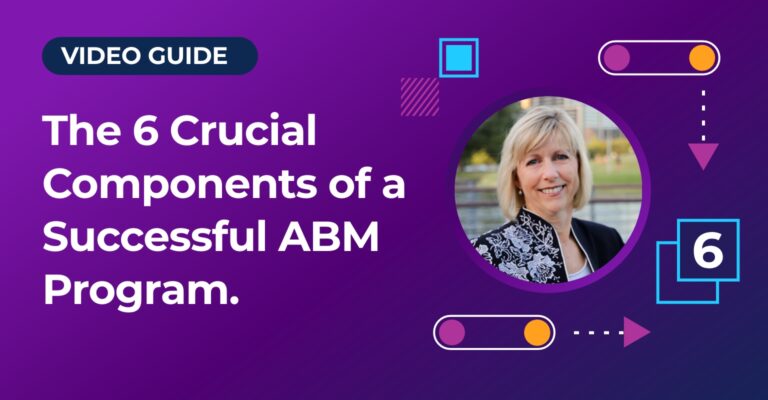Blog

You’ve worked relentlessly for the last three months building your account based marketing (ABM) strategy. You’ve identified your tech stack, redefined your ideal customer profile (ICP), pinpointed the right target accounts using engagement and intent intelligence and crafted the perfect channel mix to hit your program goals. Yet, as you step back, a crucial question surfaces: is your BDR team’s current inbound and outbound sales process truly aligned with these ambitious ABM goals?
This alignment is the bedrock of ABM program success and ultimately, revenue growth. It’s also the area that demands the most significant change management—and if it’s not clearly defined, your ABM program is unfortunately set up for failure.
In this blog, I walk through four critical areas of alignment: account assignment, lead routing, inbound and outbound balancing, and incentives. You’ll find:
- The essential questions to ask your own BDR team
- Common problems to listen for—and what they tell us demand gen marketers,
- The actions to take so your ABM strategy can thrive
Make sure to download the B2B Sales Enablement BDR Checklist so you can have this information handy when you’re talking to your BDR team!
1. Account assignment that sets the foundation for success.
Clear account assignment directly impacts BDR motivation, their ability to focus and, ultimately, their success in generating qualified opportunities. However, without a clear strategy, account assignment can quickly become blurry, leading to confusion, duplicated efforts and missed opportunities within your ABM framework.
Questions to ask your BDR leader about account assignment.
- How are accounts currently assigned to BDRs? Is it based on territory, account type or an inbound vs. outbound focus?
- Are there any documented processes or guidelines for account assignment that the team follows?
- What are your challenges or pain points associated with the existing account assignment strategy?
2. Lead routing processes built to ensure timely follow-up.
Efficient lead routing is a game-changer. It empowers BDRs to focus on their core strengths: qualifying leads and generating pipeline. When routing is smooth, it minimizes wasted effort, maximizes conversion rates, and directly contributes to BDR success and the overall triumph of your sales organization.
Questions to ask your BDR leader about lead routing.
- Can you walk me through the current lead routing process, and what systems or tools are involved in it?
- What are the different lead sources, and are they handled differently based on their origin (e.g., website forms vs. event leads)?
- Are there any Service Level Agreements (SLAs) in place for BDR lead response times? If so, can you share the documentation for these?
3. Balancing inbound and outbound efforts.
A successful ABM strategy requires a balanced approach to lead generation and a strong emphasis on tracking outbound efforts to identify what truly works.
Questions to ask your BDR leader about tracking and measurement.
- How is the BDR team structured, and how do individual BDRs typically allocate their time between inbound and outbound lead handling?
- For outbound activities, how do BDRs currently track their efforts (e.g., calls made, emails sent, social selling interactions)? What specific tools are they using for this?
- What key metrics are currently used to measure both the activity and effectiveness of outbound efforts?
4. Incentives that actually motivate your BDRs.
A thoughtfully designed incentive model for BDRs is more than just compensation—it’s a powerful tool that encourages BDRs to focus on the activities that drive the most value for the sales organization. This includes generating qualified leads, booking meetings with key decision makers, and achieving specific outreach goals.
By providing a clear link between effort and reward, incentives motivate BDRs to work harder, smarter, and more consistently. Ultimately, a well-designed incentive model can significantly impact BDR motivation, leading to a much higher success rate for your ABM strategy.
Questions to ask your BDR leader about incentives.
- Are BDRs currently incentivized beyond their base salary? If so, what are the specific incentives (e.g., bonuses for qualified opportunities, meetings booked, deals closed)?
- If no formal incentives are currently in place, what are your thoughts on potential incentive models that could motivate the team? (It helps to have the BDR leader’s feedback on what would work well to ensure buy-in for creating a new model.)
Empowering your BDR team for growth.
By asking your BDR team the right questions, and truly listening to their responses, you can gain invaluable insights into your BDR operations and identify key areas for improvement. Getting a better understanding of account assignment, lead routing, team focus, tracking mechanisms and incentive structures will enable you to optimize processes, boost BDR motivation and foster stronger sales and marketing alignment to ensure your ABM strategy is a success.
Remember, understanding the nuances of your BDR team’s activities—from how they handle inbound versus outbound leads to how they’re incentivized—is not just about efficiency; it’s about empowering your BDRs to succeed. This, in turn, fuels a more effective sales organization and drives sustainable revenue growth. Take these questions to your BDR leaders, start the conversation and begin building a stronger foundation for sales success.
The Iron Horse insight.
Ultimately, this isn’t a one-and-done exercise. What becomes more powerful is when Sales and Marketing truly become partners, continuously refining these processes together. By fostering open dialogue and a shared commitment to adaptation, you’re not just optimizing a program; you’re building a resilient, revenue-generating engine ready for whatever the market throws its way.
Don’t forget to download the B2B Sales Enablement BDR Checklist to guide your conversation with your BDR team!

6 steps to successful ABM implementation Watch video
Subscribe to our blog.
Get unstuck with the most interesting business ideas and our insights delivered to your inbox.